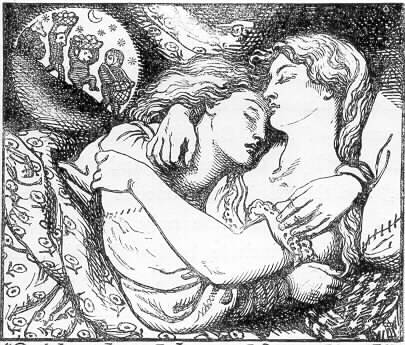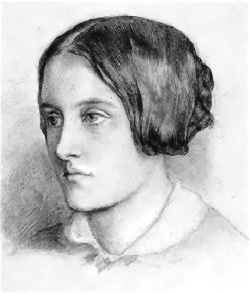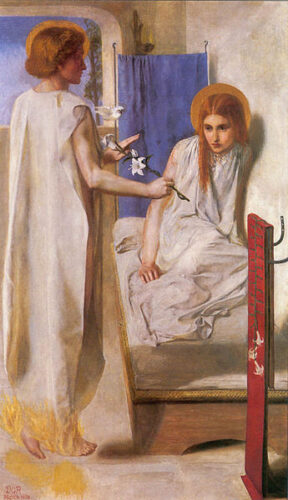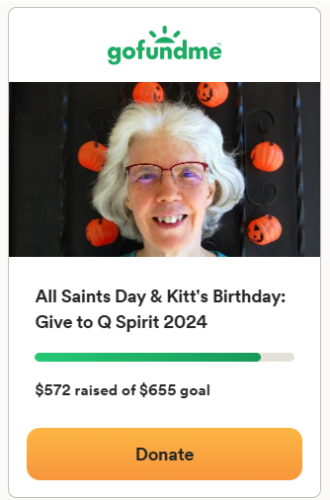Last Updated on September 26, 2024 by Kittredge Cherry

Christina Georgina Rossetti was a 19th-century English poet whose work ranged from Christmas carols to sensuous lesbian love poetry. A devout Christian who never married, she has been called a “queer virgin” and “gay mystic.” Her feast day is April 27 on the Church of England calendar.

Portrait of Christina Rossetti by Dante Gabriel Rossetti
Many consider her to be one of Britain’s greatest Victorian poets. Rossetti’s best-known works are the Christmas carol “In the Bleak Midwinter” and “Goblin Market,” a surprisingly erotic poem about the redemptive love between two sisters who overcome temptation by goblins. The homoeroticism is unmistakable in verses such as these:
She cried, “…Did you miss me?
Come and kiss me.
Never mind my bruises,
Hug me, kiss me, suck my juices
Squeez’d from goblin fruits for you,
Goblin pulp and goblin dew.
Eat me, drink me, love me…”She clung about her sister,
Kiss’d and kiss’d and kiss’d her…
She kiss’d and kiss’d her with a hungry mouth.
Some of these verses were set to music in a choral piece commissioned by the Sydney Gay and Lesbian Choir: “Heartland” by Matthew Hindson.
There is no direct evidence that Rossetti was sexually involved with another woman, but historian Rictor Norton reports that her brother destroyed her love poems addressed to women when he edited her poetry for publication. Rossetti is included in “Essential Gay Mystics” by Andrew Harvey. A comprehensive chapter titled “Christina Rossetti: The Female Queer Virgin” appears in “Same Sex Desire in Victorian Religious Culture
” by Frederick S. Roden. Rossetti is also important to feminist scholars who reclaimed her in the 1980s and 1990s as they sought women’s voices hidden in the church’s patriarchal past.
Rossetti (Dec. 5, 1830 – Dec. 29, 1894) was born in London as the youngest child in an artistic family. Her brother Dante Gabriel Rossetti became a famous Pre-Raphaelite poet and artist. Encouraged by her family, she began writing and dating her poems starting at age 12.
When Rossetti was 14 she started experiencing bouts of illness and depression and became deeply involved in the Anglo-Catholic Movement of the Church of England. The rest of her life would be shaped by prolonged illness and passionate religious devotion. She broke off marriage engagements with two different men on religious grounds (and rejected a third man’s proposal for unclear reasons). She stayed single, living with her mother and aunt for most of her life.

Christina posed for this Annunciation by Dante Gabriel Rossetti
During this period she served as the model for the Virgin Mary in a couple of her brother’s most famous paintings, including his 1850 vision of the Annunciation, “Ecce Ancilla Domini” (“Behold the Handmaid of God.”)
Starting in 1859, Rossetti worked for 10 years as a volunteer at the St. Mary Magdalene “house of charity” in Highgate, a shelter for unwed mothers and former prostitutes run by Anglican nuns. Some suggest that “Goblin Market” was inspired by and/or written for the “fallen women” she met there.
“Goblin Market” was published in 1862, when Rossetti was 31. The poem is about Laura and Lizzie, two sisters who live alone together and share one bed. They sleep as a couple, in Rossetti’s vivid words:
Cheek to cheek and breast to breast
Lock’d together in one nest.
But “goblin men” tempt them with luscious forbidden fruit and Laura succumbs. After one night of indulgence she can no longer find the goblins and begins wasting away. Desperate to help her sister, Lizzie tries to buy fruit from the goblins, but they refuse and try to make her eat the fruit. She resists even when they attack and try to force the fruit into her mouth. Lizzie, drenched in fruit juice and pulp, returns home and invites Laura to lick the juices from her in the verses quoted earlier. The juicy kisses revive Laura and the two sisters go on to lead long lives as wives and mothers.
“Goblin Market” can be read as an innocent childhood nursery rhyme, a warning about the dangers of sexuality, a feminist critique of marriage or a Christian allegory. Lizzie becomes a Christ figure who sacrifices to save her sister from sin and gives life with her Eucharistic invitation to “Eat me, drink me, love me…” The two sisters of “Goblin Market” are often interpreted as lesbian lovers, which means that Lizzie can justifiably be interpreted as a lesbian Christ.
Rossetti was an important inspiration to a younger English poet who is also frequently considered queer because of his homoerotic themes: Gerard Manley Hopkins. Fourteen years younger than her, he was a Catholic convert and a priest. They shared a passion for religious poetry and met in person once, in 1864. Rossetti was an Anglo-Catholic without actually converting to Catholicism, but some of her contemporaries did. Late 19th-century and early 20th-century literary figures who converted to Catholicism include Hopkins, Oscar Wilde, Radclyffe Hall, Lord Alfred Douglas, Marc-André Raffalovich, John Gray and Siegfried Sassoon.
In 1872 Rossetti was diagnosed with Graves Disease, an auto-immune thyroid disorder, which caused her to spend her last 15 years as a recluse in her home. She died of cancer on Dec. 29, 1894 at age 64.
She wrote the words to “In the Bleak Midwinter” in 1872 in response to a request from Scribner’s Magazine for a Christmas poem. It was published posthumously in 1904 and became a popular carol after composer Gustav Holst set it to music in 1906. Her poem “Love Came Down at Christmas” (1885) is also a well known carol. “In the Bleak Midwinter” continues to be sung frequently in churches, by choirs, and on recordings by artists such as Sarah McLaughlin (video below), Julie Andrews, Loreena McKennitt, Susan Boyle and James Taylor. The haunting song includes these verses:
Enough for Him, whom cherubim
Worship night and day,
A breastful of milk,
And a mangerful of hay;
Enough for Him, whom angels
Fall down before,
The ox and ass and camel
Which adore.
Angels and archangels
May have gathered there,
Cherubim and seraphim
Thronged the air –
But only His mother
In her maiden bliss
Worshipped the Beloved
With a kiss.
The Episcopal Church considered devoting a feast day to Christina Rossetti on April 27 with this prayer for possible inclusion on the official calendar:
O God, whom heaven cannot hold, you inspired Christina Rossetti to express the mystery of the Incarnation through her poems: Help us to follow her example in giving our hearts to Christ, who is love; and who is alive and reigns with you and the Holy Spirit, one God, in glory everlasting. Amen.
Rossetti herself may well have felt ambivalent about being honored by the church or outed as a queer. She shared her own thoughts for posterity in her poem “When I am dead, my dearest” (1862):
___
___
To read this article in Russian, go to
Святая Кристина Россетти: от рождественских песнопений до лесбийской поэзии (nuntiare.org)
___
Top image credit:
Cover illustration for Christina Rossetti’s “Goblin Market and Other Poems” (1862) by Dante Gabriel Rossetti
___
This post is part of the LGBTQ Saints series by Kittredge Cherry. Traditional and alternative saints, people in the Bible, LGBTQ martyrs, authors, theologians, religious leaders, artists, deities and other figures of special interest to lesbian, gay, bisexual and transgender and queer (LGBTQ) people and our allies are covered.
This article was originally published on Q Spirit in April 2017, was expanded with new material over time, and was most recently updated on Sept. 26, 2024.
Copyright © Kittredge Cherry. All rights reserved.
Qspirit.net presents the Jesus in Love Blog on LGBTQ spirituality.








What rubbish! Christina Rossetti was not queer or a lesbian. She was just a devoutly religious person, who rejected those who asked her to marry them because they weren’t of the same denomination of Christianity as herself (and she probably wasn’t attracted to them or found them interesting). Just because someone didn’t marry or enter into a relationship doesn’t automatically make them queer. And I’m not even a Christian saying this. She was probably more likely to be Demisexual or Asexual like myself.. (And I’m a straight Asexual, not Queer).
It’s disgusting for you to say this about her when she most likely wasn’t Lesbian at all!
For one she supposedly didn’t see herself as a feminist, or aligned with suffragettes and actively opposed that sort of thing, which you’d think she’d be for if she was a Lesbian.
It also shows how little you know, as she broke off marriage with three men, not two. Please do your research before writing articles.
She was in love with Jesus, not Mary!
Much of this is a matter of opinion and interpretation, but you are correct that she rejected three marriage proposals. I edited my text to make it clearer. Here is the new version: “She broke off marriage engagements with two different men on religious grounds (and rejected a third man’s proposal for unclear reasons).”
So the only basis for declaring her a lesbian is a weird poem about a woman who is addicted to goblin fruit and so her biological sister saves her by getting covered in juice “squeez’d from goblin fruits” so the other one can drink the goblin fruit juice. Of all the dozens of ways to interpret this poem, a lesbian romance is way down on the credibility list.
I will say that Christina Rossetti’s poetry has been researched and interpreted for many decades, and some have concluded that her work coul be considered “lesbian” poetry, especially her work “Goblin Market” – but it is by no means conclusive.